Orion XT-8:
8-inch Reflector
on
Dobsonian Mount
This is the telescope that I use most. Why? Three reasons:
- Simple -- plop it on the ground, pull off the dust covers, stick in an eyepiece, look through a finder scope, and observe.
- Hand-powered -- do not need electricity or battery pack.
- Lots of aperture. Aperture refers to the size of the main optical element in a telescope. In this case, the scope has an 8-inch diameter main mirror. This mirror collects a lot of light from celestial objects thereby showing excellent detail in most objects.
If you are looking for a first scope, I strongly recommend an 8-inch Dob -- plenty of aperture; simple; several manufacturers sell these scopes and they all have good quality optics; low-cost for what you get so you can stretch your budget to include some accessories. This was the first scope I ever owned and I recommend an 8-inch Dob as a first scope.
UPDATE: I do not use this scope any longer. In January 2005 we moved to the Mississippi Gulf Coast where we were living in an apartment and building a house near the beach. On 29 August 2005 Hurricane Katrina destroyed the Gulf Coast -- my XT-8 was among the items we lost. Here is a link to our Katrina story.
The XT-8 is a fine scope for a beginner and for an experienced observer. I purchased an Orion XT-12 to replace this scope but I plan to buy another XT-8 around the first of 2007 -- the XT-12 is BIG!!
Orion XT-8
What does it look like? Here's a photo. The long black tube is contains the optics -- the primary mirror, secondary mirror, and eyepiece holder -- this is the scope, the other part is the Dobsonian mount. Scroll down for detailed photos.
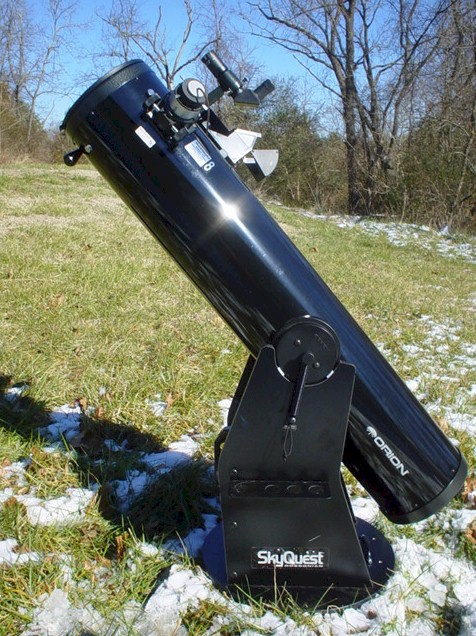
Visit the Orion web site to see details about this scope. You can also purchase Dobsonians from Hardin Optics, Meade, Celestron, Discovery, and several other dealers. You will be pleased with any of them. Use a search engine and search the Web for "Dobsonian telescopes."
Finder scopes
When you look through a telescope, you see only a tiny slice of the sky. You must have something to show a broader view of the sky to help you point the scope in the right direction -- these are known as "finder scopes." Finder scopes have low or no magnification. They have mounting screws that move them around and allow you to calibrate the finder so that whatever is in the center of the finder is also in the center of the scope when you look through the eyepiece. I have two finder scopes on my XT-8: (1) a right-angle 8x25 scope and (2) a Telrad zero magnification finder. The right-angle finder is obvious -- it's sticking up on top of the scope. The Telrad is the long black box stuck to the scope; it's facing you in this photo, it has a little square glass window on it.
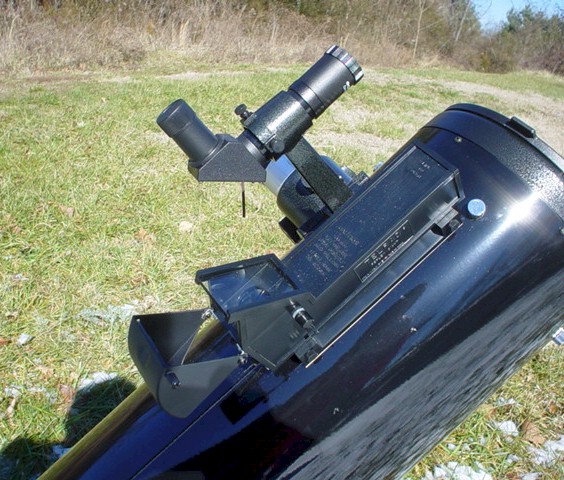
I will not try to explain the operation of the Telrad -- go to their website and read about it. The XT-8 comes with a single straight-through finder. I find that the right-angle finder is more convenient. The Telrad is also necessary. After you get a Dob, I recommend you eventually upgrade to a right-angle finder and a Telrad.
Telrad resources
These folks manufacture and sell the Telrad. Scroll down the page to find the Telrad.
This site has detailed descriptions of how the Telrad works, how to mount and align it.
My modification to the XT-8
Orion lists the XT-8 as weighing 42 pounds -- that's the total weight of the scope and its mounting base. The scope tube is 44 inches long and almost 10 inches in diameter. I am 59 years old and lift weights three days a week -- I bench press 185 pounds and curl 100 pounds and I can handle this scope without any problem. However, some folks find the 8-inch scope to be a handful. You can easily lift the tube off the base and carry them separately -- that's how I transport the scope in my pickup truck.
Here is a link to the Orion owner's manual for the XT-8 -- it is a .pdf file so you need Adobe Acrobat pdf reader to see this file -- most people have Adobe -- print this manual, it has a lot of info. Check out the photos that describe how to carry the scope.
Look at this photo -- notice the large handle on the front of the base (not a good picture -- look closely, the handle is vertical, in the center of the front panel). You can pick up the scope by this handle and carry it with one hand like a really big suitcase. The thing with the four holes in it is an eyepiece rack -- when you use the scope, you will be using different eyepieces, this rack gives you a place to stash the eyepieces you are not using.
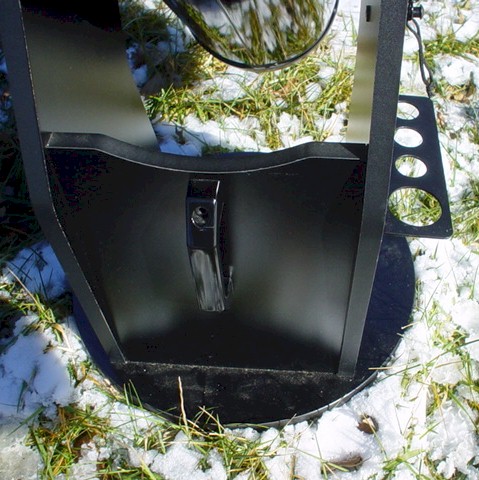
I added another handle to my scope's base. Look at this photo (the two empty holes are mistakes -- I drilled them in the wrong place). My handle is attached with two silver bolts and nuts -- the handle is not really clear in the photo.
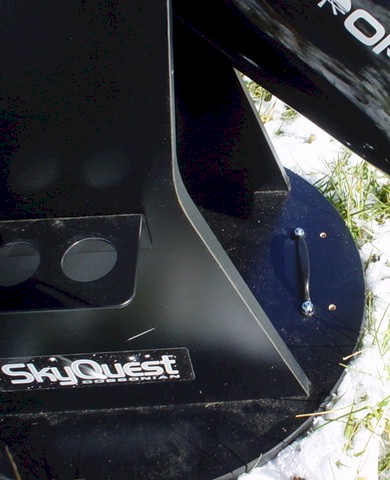
Now, I carry the scope assembled. I stand the tube up vertical; I squat down beside the scope, grasp the stock handle with my left hand, grasp my handle with my right hand, and stand up -- I am now holding the scope and base in two hands, the tube is vertical, and I find this a lot easier than trying to carry the scope like a suitcase.
Miscellaneous items for the XT-8
Looking down the tube
See the 8-inch mirror at the bottom of the tube? Note the tiny, tiny spot that marks the center of the mirror -- you need this to collimate the scope. Don't get excited about collimation -- you'll need to do it now and then but it's no big deal -- here is my collimation page. If you buy a reflector scope, make certain the mirror comes from the factory with a center mark -- if not, you must remove the mirror and center mark it. The big dark spot in the center of the mirror is the reflection of the secondary mirror, which is mounted at the near end of the tube. The center mark is the very tiny dot on the mirror above the secondary reflection.
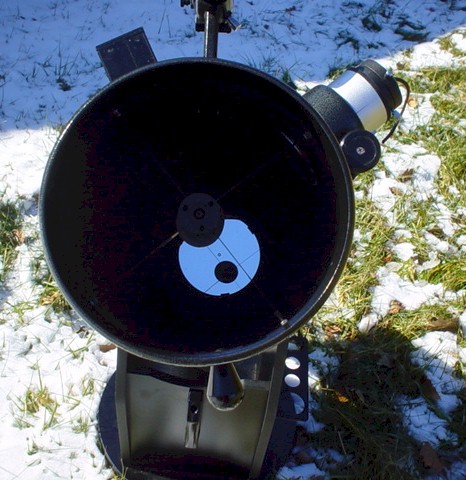
Eyepiece opening cover
There is another article on this site discussing eyepieces. Basically, the eyepiece is the part of the scope that focuses the image into a point where you can put your eye and see through the scope. Eyepieces plug into the XT-8 focuser -- the focuser has a rack-and-pinion gear arrangement that moves the eyepiece in and out to focus it. My eyepieces are 1.25-inch diameter, so, there is a big 1.25-inch hole where crap can fall down the tube onto my primary mirror. I use an empty 35mm film canister to plug this hole. Note the leather thong -- I use this to pull the 35mm plug out of the focuser opening when I need to insert an eyepiece.
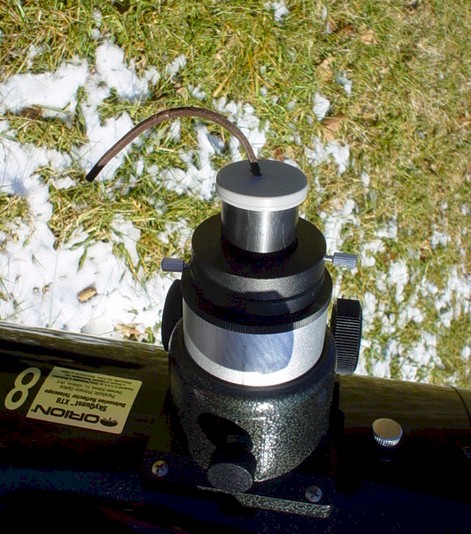
Adjusting the focuser tension
The focuser on the XT-8 is a rack-and-pinion type -- eyepieces are inserted into the focuser opening and a lock screw tightened on them. Inside the tube where the eyepiece mounts is a long piece of Teflon. Over time, the rack-and-pinion gears wear and the eyepiece does not fit perfectly into the holder. When you notice the eyepiece wobbling in the focuser, you need to tighten the set screws that press the Teflon pad against the eyepiece. On the XT-8, this is done with a 1.5mm hex wrench. There are two set screws to tighten -- in this photo, my finger is pointing to the top one -- the bottom one is below the knob just beneath my finger. You need to tighten these only a little and only occasionally -- I did this once in a year. While this description is for the Orion XT-8, the focusers on other brands of reflectors are probably similar -- look carefully at your focuser.
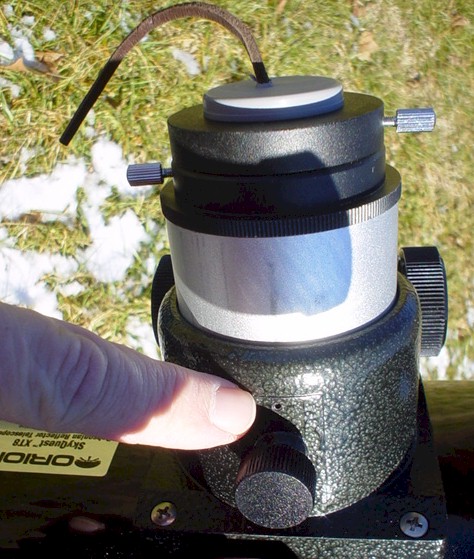
The scope cart
I live in an apartment. The apartment complex has garages and storage units for rent. Each garage unit has a 4 x 12 foot storage closet and the storage units are 8 x 12. We rent both a garage and a storage unit. The XT-8 lives in the storage unit along with its cart, eyepieces, and Denver Observing Chair. Click here for a view of the scope cart loaded up and ready to roll.
Collimation
When you read about reflector scopes, you will encounter the term "collimation." Here is an article about my experiences with collimation. You will need to collimate your reflector -- it's simple after you have done it one time.
I will add to this article as I have more suggestions for my XT-8.
This page last modified on: 27 Dec 2021
Bottom Line
The Orion XT-8 is a fine telescope for the amateur astronomer -- I am perfectly delighted with mine.